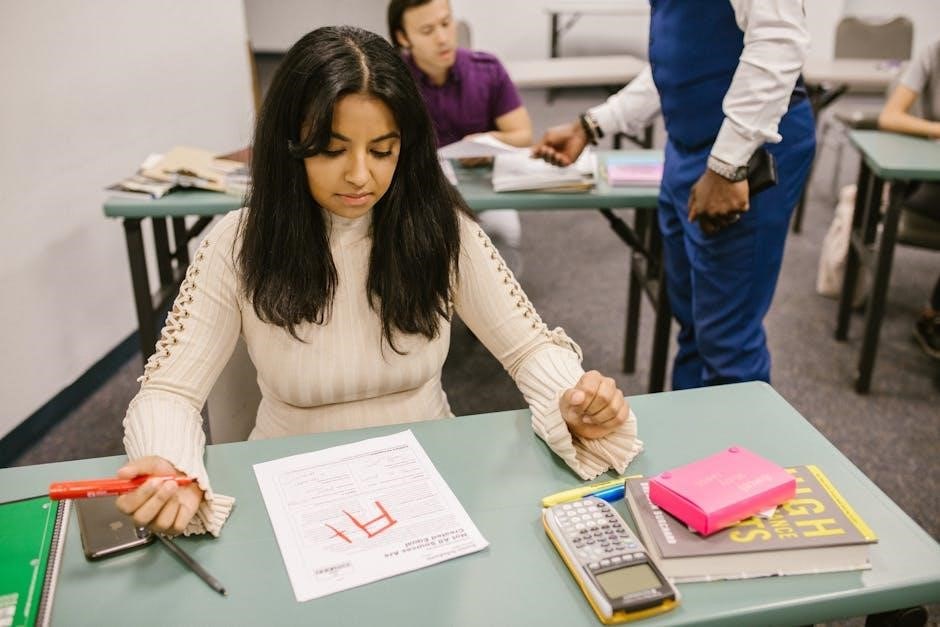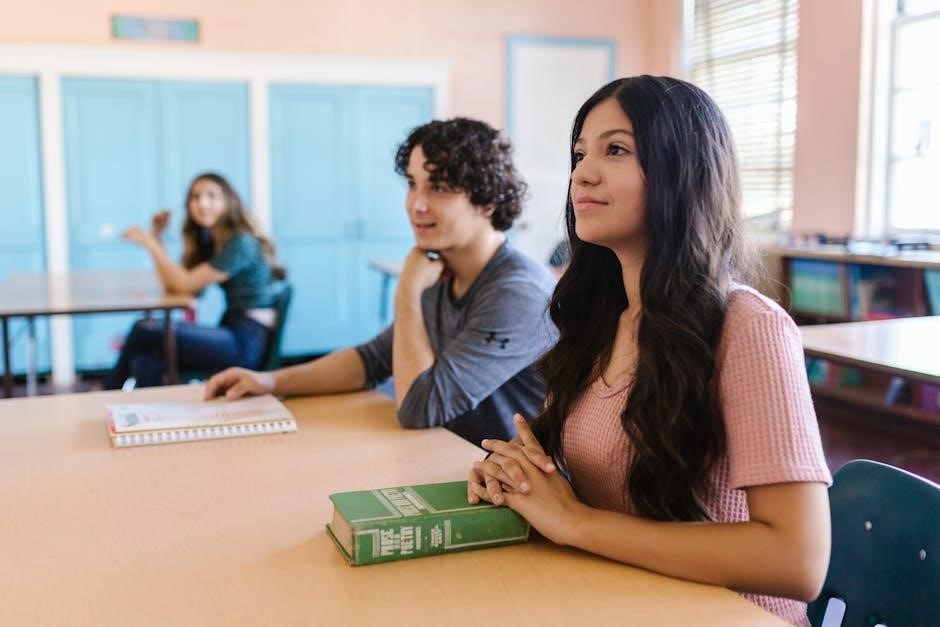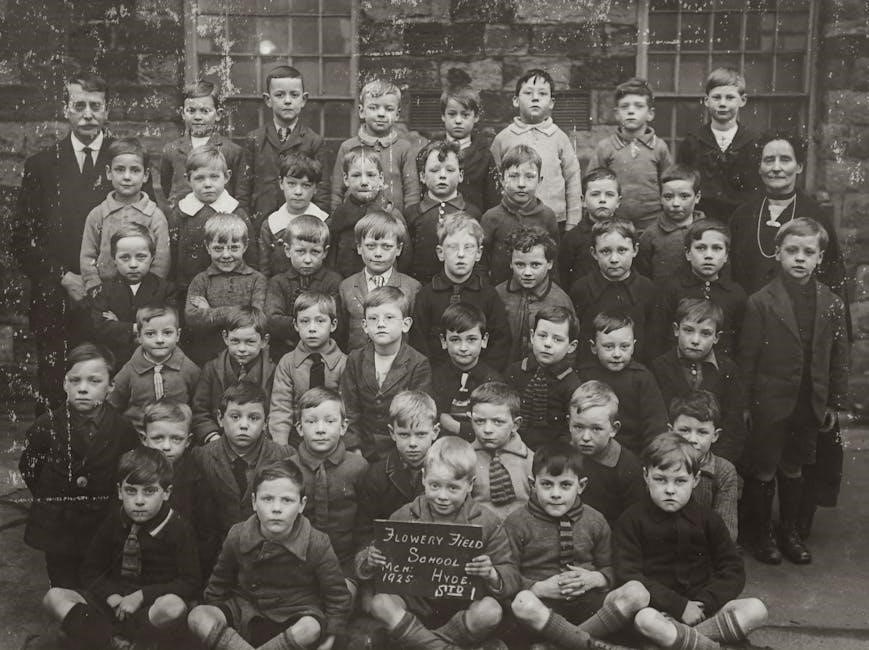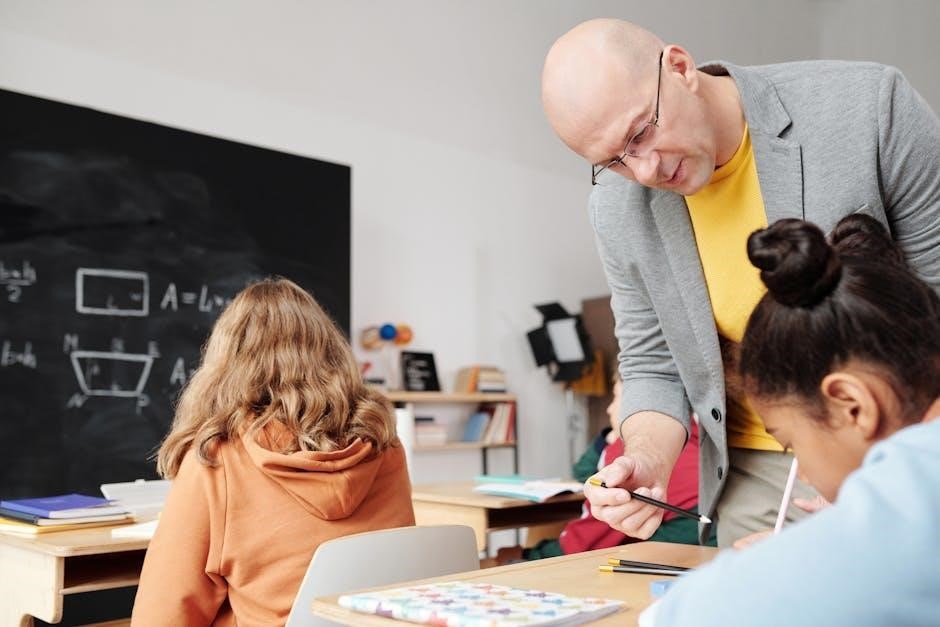Pointillism is an artistic technique using small dots of color to create detailed images. It emphasizes optical blending, developed in the late 19th century by Georges Seurat and Paul Signac.
1.1 Definition and History of Pointillism
Pointillism is a painting technique developed in the late 19th century by Georges Seurat and Paul Signac. It involves creating images using small dots of color, which blend optically to form detailed, vibrant compositions. This method contrasts with traditional approaches, emphasizing scientific color theory and precision. Historically, it emerged as a response to Impressionism, seeking to innovate artistic expression through structured, methodical application of color and form.
1.2 Key Characteristics of Pointillism
Pointillism is distinguished by its use of small, distinct dots of color applied in patterns to form an image. It relies on optical blending, where the viewer’s eye mixes the dots to perceive a range of colors and tones. This technique eliminates brushstrokes, creating a smooth, unified surface. It also emphasizes scientific color theory, with careful placement of dots to achieve precise chromatic effects and textures. Additionally, Pointillist works often feature a sense of luminosity and depth, as the dots can be layered to build intricate visual dimensions. The method requires patience and precision, as each dot contributes to the overall composition. The technique’s structured approach contrasts with the spontaneity of other painting styles, making it both challenging and rewarding for artists. By focusing on color theory and methodical application, Pointillism offers a unique visual language that explores the boundaries of perception and artistic expression.

Preparing for the Class
Teachers should gather materials, set up the classroom, and plan engaging activities. Consider using AI tools to create structured lesson plans and ensure all supplies are organized for efficiency.
2.1 Gathering Materials and Tools
Gather necessary materials such as fine-tip brushes, colored paints or markers, blank canvas, and reference images. Ensure students have access to these tools for hands-on practice. Organize supplies in labeled containers for easy access, and prepare a demonstration area for step-by-step guidance. Additionally, consider incorporating digital tools for visual aids to enhance the learning experience and cater to diverse learning styles.
2.2 Setting Up the Classroom Environment
Arrange tables and chairs to facilitate group work and individual creativity. Ensure good lighting and a clean workspace. Place materials like paints, brushes, and canvases within easy reach. Consider incorporating technology, such as tablets for digital pointillism, and display examples of pointillist art for inspiration. Create a distraction-free environment to encourage focus and engagement during the activity.

Demonstrating the Pointillism Technique
Demonstrate creating small, precise dots to form images. Explain color theory and optical mixing. Use examples to show how dots blend to create vibrant, detailed artwork.
3.1 Step-by-Step Guide to Creating a Pointillist Painting
- Start by preparing your materials, including fine brushes or styluses for applying dots.
- Sketch a light composition outline on your canvas or paper.
- Begin applying small dots in layers, starting with base colors.
- Allow each layer to dry before adding details to avoid muddying colors.
- Experiment with color theory by mixing dots to create vibrant hues optically.
- Guide students to work from light to dark, building contrast gradually.
- Encourage patience and focus, emphasizing the meditative nature of the process.
3.2 Explaining Color Theory and Dot Placement
Teach students how colors mix optically when dots of primary and secondary hues are placed side by side. Demonstrate how warm and cool tones create contrast. Emphasize the importance of spacing and layering dots to achieve depth and vibrancy. Guide students in applying dots systematically, starting with light layers and building up for intricate details. Highlight patience as key to mastering the technique.
Structuring the Lesson Plan
Organize the lesson into warm-up exercises, guided practice, and independent work. Ensure a logical flow, allowing students to progress from basic techniques to applying them creatively.
4.1 Warm-Up Exercises
Begin with short, simple exercises to familiarize students with pointillism. Start with basic dotting techniques using different tools. Introduce color mixing by layering dots. Encourage students to practice creating gradients and textures. Keep exercises brief, 5-7 minutes, to maintain focus. Circulate to assist and provide immediate feedback. This prepares students for more complex tasks ahead.
4.2 Guided Practice
Lead students through a step-by-step pointillist exercise. Demonstrate techniques like dot placement and color blending. Provide a simple project, such as creating a small still life or landscape. Offer guidance on layering dots and achieving depth. Circulate to assist and answer questions. Ensure students understand the process before moving to independent work. This structured practice reinforces concepts and builds confidence.
4.3 Independent Work
During independent work, students apply pointillism techniques to personal projects. Encourage creativity and individual style while monitoring progress. Offer one-on-one support to address challenges. Foster a self-directed learning environment, allowing students to explore and express their artistic vision freely. The teacher observes and assists as needed to ensure understanding and completion.

Encouraging Student Creativity
Encourage students to explore unique compositions and color palettes in their pointillist works. Foster an environment where originality and self-expression are celebrated, challenging traditional norms.
5.1 Allowing Freedom in Composition
Encourage students to choose their own subjects and layouts, fostering personal expression. Allow experimentation with abstract or representational styles, emphasizing the freedom to interpret pointillism uniquely. This approach helps students develop creative confidence and understand how composition impacts the visual narrative in their artworks;
5.2 Promoting Experimentation with Colors
Encourage students to explore color theory by experimenting with primary and secondary hues, warm and cool tones, and monochromatic schemes. Demonstrate how colors can blend optically when applied in dots. Allow students to test color combinations and observe how they interact. This fosters creativity and helps them understand how color placement and layering can enhance their pointillist artworks.

Providing Feedback and Guidance
Offer constructive feedback on technique, composition, and color use. Guide students individually, addressing strengths and areas for improvement. Encourage questions and open dialogue to foster growth and understanding of pointillism principles.
6.1 Offering Constructive Criticism
When providing feedback, focus on specific aspects of the student’s work, such as technique, composition, or color harmony. Highlight strengths and suggest areas for improvement in a supportive manner; Use positive language to encourage refinement while maintaining the student’s confidence. This balanced approach helps students understand how to enhance their pointillism skills effectively.
6.2 Encouraging Peer Reviews
Encourage students to share their work with classmates, fostering a collaborative environment. Peer reviews allow students to see different perspectives and techniques, enhancing their understanding of pointillism. Guide them to provide thoughtful feedback, focusing on color choices and composition. This exchange promotes mutual learning and refines their critical thinking skills while building confidence in their artistic abilities.

Managing Classroom Dynamics
Create a positive and respectful environment where all students feel comfortable participating. Encourage collaboration and focus to ensure a productive and engaging learning experience.
7.1 Maintaining Focus and Engagement
To maintain focus, provide clear demonstrations and hands-on practice. Use positive reinforcement to encourage students. Incorporate movement breaks to refresh minds. Encourage questions and discussions to foster engagement; Create a supportive environment where students feel comfortable exploring their creativity. These strategies help sustain interest and motivation throughout the pointillism lesson, ensuring active participation and a productive learning atmosphere for all students involved.
7.2 Handling Challenges and Questions
Address challenges by offering one-on-one support and encouraging students to share difficulties. Foster open discussions to clarify doubts and explore creative solutions. Use visual aids to demonstrate techniques and provide additional examples. Encourage peer assistance to build a collaborative environment. Stay patient and positive, ensuring all questions are answered to help students overcome obstacles and achieve their artistic goals effectively.

Assessing Student Understanding
Assess students by observing their technique during activities and evaluating their final artwork for understanding of color theory and precision in dot placement.
8.1 Observing Progress During the Activity
Monitor students as they work, paying attention to their technique and understanding of color theory. Circulate the room to offer guidance and answer questions. Observe how they apply dots and mix colors. Provide immediate feedback to help refine their skills. Note improvements and areas needing more practice, ensuring everyone stays engaged and on track.
8.2 Reviewing Final Pieces
Evaluate students’ finished artwork to assess their grasp of pointillism. Look for effective use of dot techniques, color blending, and composition. Provide constructive feedback, highlighting strengths and suggesting areas for improvement. Encourage students to reflect on their work and share their creative decisions. Use this opportunity to reinforce key concepts and celebrate their artistic achievements.
Time Management Strategies
Plan and allocate time for demonstrations, guided practice, and independent work. Ensure smooth transitions between activities to maximize productivity within the class duration.
9.1 Allocating Time for Each Activity
Allocate time wisely: 10 minutes for introduction and demonstration, 15 minutes for warm-up exercises, 20 minutes for guided practice, and 30 minutes for independent work. Ensure smooth transitions between activities to maintain focus. Adjust timings based on class length and student progress to ensure all aspects of the lesson are covered effectively without rushing or prolonging unnecessarily.
9.2 Ensuring Completion Within the Class Duration
Monitor progress closely and adjust activity pacing to fit the class duration. Set clear deadlines for each segment to keep students on track. Provide time checks and gentle reminders to ensure tasks are completed. Be flexible to accommodate challenges while maintaining the lesson’s flow and ensuring all key activities are finished within the allocated time.

Resources and Materials
Essential materials include acrylic or oil paints, small brushes, and sturdy paper or canvas. Reference books and digital tools can enhance learning. Safety equipment is a must.
10.1 List of Required Art Supplies
- Acrylic or oil paints in primary and secondary colors
- Small, round paintbrushes (sizes 0-5)
- Canvas or heavy-duty paper
- Palette or mixing surface
- Water cup and paper towels
- Graphite pencil and eraser
- Optional: Dotting tools (e.g., toothpicks or styluses)
- Color theory chart for reference
- Turpentine (for oil paints)
- Safety gloves and goggles
10.2 Recommended Reference Materials
Provide students with art history books on Pointillism, color theory guides, and prints of famous works by Seurat and Signac. Include instructional handouts detailing techniques and dot placement. Offer access to online tutorials and documentaries on the movement. These resources will deepen understanding and inspire creativity during the lesson.
Addressing Common Challenges
Address common challenges by encouraging patience and precision. Many students may struggle with the repetitive nature of Pointillism, requiring close attention to detail and time management.
11.1 Helping Students with Patience and Precision
Help students develop patience by breaking tasks into smaller, manageable steps. Encourage focus through guided practice and positive reinforcement. Demonstrate how precision in dot placement enhances the final piece. Use visual aids to illustrate progress and celebrate small achievements. Emphasize the meditative aspect of the technique to foster calm and dedication. Provide one-on-one support for those struggling with detail-oriented work.
11.2 Supporting Students with Fine Motor Skills
Modify tools by using larger dotting instruments or adaptive grips for easier handling. Provide hand-strengthening exercises, such as finger stretches, to improve dexterity. Offer pre-printed templates with spaced dots to reduce physical demands. Allow verbal cues or physical support for precise placements. Encourage students to work at their own pace, celebrating progress and effort throughout the activity.

Cultural and Historical Context
Explore pointillism’s roots in 19th-century France, led by Georges Seurat and Paul Signac. Discuss its evolution from Impressionism and how it emphasized scientific color theory.
12.1 Discussing the Origins of Pointillism
Pointillism emerged in the late 19th century, pioneered by Georges Seurat and Paul Signac. It evolved as a response to Impressionism, focusing on scientific color theory. The technique involves applying small, distinct dots of color in patterns to form an image. This method allows the viewer’s eye to blend the colors optically, creating a sense of luminosity and detail. Discuss its historical development and artistic philosophy.
12.2 Highlighting Famous Pointillist Artists
In the realm of Pointillism, Georges Seurat and Paul Signac stand out as pioneers. Seurat’s masterpiece, ‘A Sunday Afternoon on the Island of La Grande Jatte,’ exemplifies the technique’s potential. Signac’s ‘Portrait of Félix Fénéon’ displays his mastery of color. Other notable artists include Henri-Edmond Cross and Maximilien Luce, who expanded the movement’s reach. Their innovation in applying small dots to create vivid, luminous scenes laid the groundwork for future art movements, such as Fauvism.
Integrating Technology
Integrate technology by using digital tools like Procreate or Adobe Illustrator to simulate pointillism, allowing precise dot placement and color theory exploration. Project examples for visual engagement.
13.1 Using Digital Tools for Pointillism
Utilize digital tools like Procreate or Adobe Illustrator to teach pointillism, enabling students to experiment with precise dot placement and color blending. These tools offer features like pixel brushes and layered canvases, making it easier to demonstrate techniques and correct work in real-time. Project examples on a screen to illustrate how digital pointillism mimics traditional methods, fostering engagement and understanding.
13.2 Sharing Online Resources
Provide students with online resources like Khan Academy’s art lessons and YouTube tutorials on pointillism. Share interactive tools such as Canva for digital dot art and websites with printable templates. Link to online galleries showcasing famous pointillist works, and recommend apps like Pixlr for experimenting with pixel art. These resources enhance learning and inspire creativity beyond the classroom.

Safety Precautions
Ensure students wear aprons and gloves when using paints. Provide well-ventilated spaces to avoid inhaling fumes. Teach proper handling of sharp tools and digital devices safely. Encourage handwashing after class and proper disposal of materials. Emphasize ergonomics when using technology to prevent strain. Always supervise students during activities.
14.1 Handling Art Materials Safely
Teachers should emphasize safe handling of art materials. Demonstrate proper use of paints, brushes, and tools. Encourage wearing gloves and smocks to protect skin. Ensure students work in well-ventilated areas to avoid inhaling fumes. Teach proper storage and disposal of materials. Remind students to keep supplies out of reach of younger children. Emphasize handwashing after handling art materials and tools.
14.2 Cleaning Up the Workspace
Teach students to clean their workspaces thoroughly. Dispose of used paper towels, empty paint containers, and leftover materials. Clean brushes with soap and water, and wipe palettes with damp cloths. Encourage organizing supplies neatly. Remind students to check their areas for forgotten items. Supervise cleanup to ensure a tidy and safe classroom environment for the next session.
Summarize key techniques and encourage reflection. Assign homework to refine skills and explore pointillism further. Provide feedback and discuss next steps for continued artistic development.
15.1 Summarizing Key Takeaways
Reiterate the fundamentals of pointillism, emphasizing dot technique, color theory, and layering. Highlight historical context and its influence on modern art. Encourage students to reflect on their learning journey, noting progress and challenges. Discuss how patience and precision are vital for mastering the style. Remind them to apply these skills in future projects.
15.2 Assigning Homework or Next Steps
Assign students to create a small pointillist piece at home, focusing on color blending and precision. Encourage experimentation with new techniques and themes. Request they bring their work to the next class for feedback. Provide optional resources for further learning, such as videos or tutorials, to deepen their understanding of the style.
